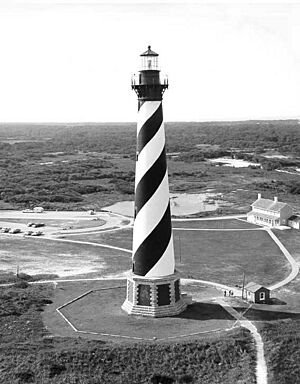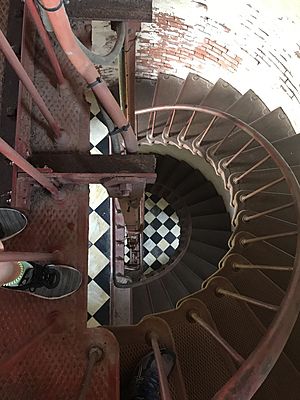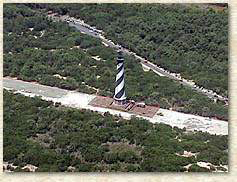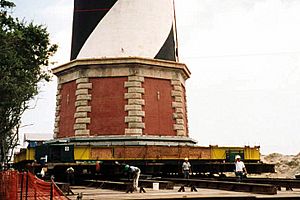Cape Hatteras Lighthouse facts for kids
| Coordinates | 35°15′2″N 75°31′43.7″W / 35.25056°N 75.528806°W |
|---|
The Cape Hatteras Light is a famous lighthouse on Hatteras Island in the Outer Banks of North Carolina. It stands in the town of Buxton, North Carolina and is part of the Cape Hatteras National Seashore. This lighthouse is the tallest in the United States, measuring 210 feet from its base to its top.
Its unique black and white spiral pattern makes it easy to spot. Many people consider it one of the most beautiful and well-known lighthouses in the country.
The Outer Banks are a chain of barrier islands along the North Carolina coast. These islands separate the Atlantic Ocean from calmer coastal waters. Ocean currents here made it easy for ships to travel, but there was a very dangerous area called Diamond Shoals. This spot is just off the coast of Cape Hatteras.
Near Cape Hatteras, the warm Gulf Stream meets the cold Labrador Current. This mix of currents often creates strong ocean storms and big waves. Because so many ships crashed on the shifting sandbars here, this area earned the nickname "Graveyard of the Atlantic." To help ships avoid these dangers, the U.S. Congress decided to build the Cape Hatteras Light.
At 198 feet tall, it is the tallest brick lighthouse in the United States. It is also the second tallest brick lighthouse in the world. Since its base is very close to sea level, its light is not the highest in the U.S. There are 14 other lights built on higher ground that shine from a greater height.
Contents
Visiting the Lighthouse and Museum
Right next to the Cape Hatteras Light, you'll find the Hatteras Island Visitor Center and Museum of the Sea. The National Park Service runs this center. It is located in the old Cape Hatteras Lighthouse Double Keepers' Quarters.
Inside, you can learn about the history of the Outer Banks. You can also discover its maritime heritage and natural history. The museum has many exhibits about the lighthouse itself. The visitor center offers information about the Cape Hatteras National Seashore. You can also find ranger programs and a bookstore there.
History of the Lighthouse
The Cape Hatteras Light has a long and interesting history. Two main lighthouses have stood at this important location.
The First Lighthouse
On July 10, 1794, Alexander Hamilton, who was the Secretary of Treasury, asked for a lighthouse to be built here. His ship almost crashed on its way to the New World. Because of this, the lighthouse was sometimes called "Hamilton's Light." Congress approved $44,000 to build a lighthouse at Cape Hatteras.
The first Cape Hatteras Lighthouse was finished in 1802. This lighthouse was built to mark very dangerous sandbars. These sandbars stretched about 10 miles from the cape. The original tower was made of dark sandstone and kept its natural color.
The first light used 18 lamps with 14-inch reflectors. It shone from 112 feet above sea level. On clear days, ships could see it from about 18 miles away.
In 1851, a Navy officer named Lt. David D. Porter said the Hatteras light was "without doubt, the worst light in the world." He explained that ships needed a strong, clear light to avoid the dangerous shoals. He often had to rely on his ship's depth finder instead of the light. He suggested the light be made much brighter and raised 15 feet higher.
Improvements began in 1845 when the reflectors were changed to 15 inches. By 1848, the 18 lamps were replaced with 15 lamps that had 21-inch reflectors. This made the light visible from 20 miles away on clear days. In 1854, a new, powerful Fresnel lens was installed. This lens made the light flash white. The tower was also made taller, reaching 150 feet.
During the Civil War, in 1860, the lighthouse needed protection. By 1862, the lens and lantern were destroyed. The light was later put back into use.
The Second Lighthouse
Sailors and Navy officers asked for a new, stronger lighthouse. So, in 1868, Congress gave $80,000 to build a new beacon at Cape Hatteras.
The new Cape Hatteras lighthouse was built in less than two years. It was finished under the direction of Brigadier General J. H. Simpson. The new lighthouse cost $167,000. The first light from this new tower shone on December 16, 1871. It was the tallest brick lighthouse tower in the world at that time. It stood 200 feet above the ground. The light itself was 208 feet above the water. The old tower was taken down in February 1871. Its ruins slowly disappeared due to storms by 1980.
In 1879, lightning struck the new tower. Cracks appeared in its walls. To fix this, a metal rod was installed. This rod connected the tower's iron parts to an iron disk buried in the ground. This acted as a lightning rod to protect it from future strikes. In 1912, the light's brightness was increased from 27,000 to 80,000 candlepower.
After the new tower was built in 1870, the sea slowly started to move closer to the beach. This became a serious problem by 1919. The high tide line was only about 120 feet from the tower's base. The waves kept eating away at the land until 1935, when the water reached the lighthouse site. People tried to stop this erosion with dikes and breakwaters, but they didn't work.
So, in 1935, the light was moved from the brick tower. An Aerobeacon was placed on top of a four-legged steel tower. This new tower was built farther back from the sea on a sand dune. It was 166 feet above the sea and visible for 19 miles. The old brick tower was then given to the National Park Service.
The Civilian Conservation Corps and Works Progress Administration built wooden barriers. These barriers helped stop the waves from washing away the beach. In 1942, German U-boats began attacking ships near the coast. The Coast Guard took control of the brick tower again. They used it as a lookout station until 1945.
By then, sand had built up on the beach. The brick tower was now 500 to 900 feet inland from the sea. It was safe to use again. The light was put back into the brick tower on January 23, 1950.
The new light was a 36-inch aviation-type rotating beacon. It had 250,000 candlepower and could be seen for 20 miles. It flashed white every 7.5 seconds. The steel tower, called the Buxton Woods Tower, was kept by the Coast Guard. It would be used if the brick tower ever became endangered by erosion again.
Today, the lighthouse has a very noticeable black and white diagonal pattern. This pattern helps sailors identify it during the day. The Coast Guard owns and operates the navigation equipment. The National Park Service takes care of the tower as a historic building.
The Cape Hatteras Lighthouse is the tallest in the United States. It stands 208 feet from its foundation to the top of its roof. To reach the light, which shines 191 feet above the water, you have to climb 268 steps. About 1,250,000 bricks were used to build the lighthouse and the main keeper's house. The U.S. Coast Guard still uses and maintains the light. It helps protect sailors from the dangerous shoals of the Graveyard of the Atlantic.
Moving the Lighthouse
In 1999, the sea was once again getting too close to the lighthouse. The Cape Hatteras lighthouse had to be moved from its original spot. It was only 15 feet from the water's edge and in great danger. The lighthouse was moved a total of 2,900 feet to the southwest. This placed it 1,500 feet from the shoreline at that time.
All the other buildings at the site were also moved. They were put back in their original positions. This kept their compass directions and their distance from the lighthouse the same. International Chimney Corp. was hired to move the lighthouse. Expert House Movers also helped.
Moving the lighthouse was a big project. Some people thought the structure would not survive the move. There were even lawsuits, but they were later dismissed. Despite some disagreements, the work went ahead. The move was completed on September 14, 1999.
The Cape Hatteras Light House Station Relocation Project became known as "The Move of the Millennium." The companies that moved it won an award for Outstanding Civil Engineering Achievement in 1999. The Cape Hatteras Lighthouse is one of the tallest brick structures ever moved. It is 200 feet tall and weighs 5,000 tons!
Lighthouse Facts
Here are some interesting facts about the Cape Hatteras Light:
- Building Material: It was built with about 1,250,000 bricks.
- Height Above Sea Level: The light shines from 210 feet above the sea.
- Structure Height: The lighthouse building itself is 198.5 feet tall.
- Daytime Markings: It has black double helix spiral stripes on a white background.
- Number of Steps: There are 257 steps to reach the light.
- Brightness: The light is very bright, with 800,000 candlepower. It uses two 1,000-watt lamps.
- Flash Pattern: The light flashes for 1 second, then is dark for 6.5 seconds.
- Visibility: You can see the light from 20 nautical miles (37 km) away in clear weather. In very good conditions, it has been seen from 51 miles (94 km) out!
See also
- List of tallest lighthouses






